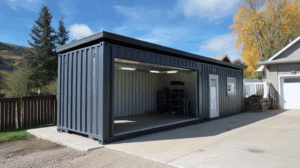Revolutionize Your Storage Space: The Benefits of Using Shipping Containers as Garages
Are you tired of clutter and disorganization in your home? Do you find yourself struggling to find enough space to store your belongings? If so, it may be time to revolutionize your storage space by considering the use of shipping containers as garages. These versatile and cost-effective storage solutions offer a range of benefits that can transform the way you think about storage.
1. Ample Space for All Your Belongings
One of the primary advantages of using shipping containers as garages is the ample space they provide. These containers come in various sizes, with the most common being 20 feet and 40 feet long. This means you can store a vast amount of items, from vehicles and equipment to furniture and household goods. With high ceilings and an open layout, shipping containers offer flexibility in organizing your possessions and optimizing your storage space.
2. Security and Protection
When it comes to storing your valuable belongings, security is of utmost importance. Shipping containers are built to withstand harsh weather conditions and provide enhanced protection against theft and vandalism. Made from durable materials such as steel, these containers offer a secure and robust storage solution. Additionally, shipping containers can be easily modified with added security features such as reinforced locks, steel doors, and security systems, ensuring your items are safe and protected.
3. Versatility and Customization
Shipping containers are incredibly versatile and can be adapted to suit a variety of storage needs. Whether you require additional space for a workshop, a home gym, or simply want to declutter your living space, these containers can be customized to meet your specific requirements. With the ability to add windows, ventilation, insulation, and electrical wiring, you can transform a shipping container into a functional and comfortable space that fits your unique storage needs.
4. Cost-Effective Storage Solution
Building a traditional garage can be a costly and time-consuming endeavor. On the other hand, using shipping containers as garages offers a cost-effective alternative. These containers can be purchased or rented at a fraction of the cost of constructing a brick-and-mortar garage. Furthermore, the modular nature of shipping containers allows for easy transportation and relocation, giving you the flexibility to move your storage space as needed.
5. Environmentally Friendly Option
In today’s world, where sustainability is a growing concern, using shipping containers as garages is an environmentally friendly choice. By repurposing these containers, you are contributing to the reduction of waste and minimizing the need for additional construction materials. Additionally, shipping containers can be retrofitted with eco-friendly features such as solar panels, rainwater harvesting systems, and green roofs, further reducing your carbon footprint.
Conclusion
If you’re looking to revolutionize your storage space and overcome the challenges of limited room and clutter, shipping containers offer an innovative and practical solution. With their ample space, security features, versatility, cost-effectiveness, and eco-friendly nature, these containers can transform the way you think about storage. Consider the benefits of using shipping containers as garages and take a step towards a more organized and efficient storage solution.
Thinking Outside the Box: Creative Ways to Utilize Shipping Containers as Garages
In today’s world, where space is limited and the cost of construction is soaring, finding innovative solutions for storage and parking needs has become a necessity. One such solution that has gained immense popularity in recent years is repurposing shipping containers as garages. These sturdy, versatile, and cost-effective structures offer a multitude of benefits and can be transformed into unique and creative spaces. In this blog post, we will explore some of the most innovative ways to utilize shipping containers as garages.
1. Compact Car Showroom
Do you have a passion for cars but lack the space to exhibit them properly? Look no further than a repurposed shipping container as your own compact car showroom. With its ample space and industrial aesthetic, a shipping container can be transformed into a stylish and secure garage to showcase your prized vehicles. Install large glass doors or windows to allow natural light in and create an inviting ambiance for visitors.
2. Workshop Wonderland
If you’re a DIY enthusiast or have a hobby that requires a dedicated workspace, a shipping container garage can be the perfect solution. Whether it’s woodworking, painting, or metalworking, you can convert a shipping container into a well-equipped workshop. Install shelves, workbenches, and storage options to maximize functionality. With the added benefit of being able to lock up your tools and equipment securely, you can have peace of mind knowing your workshop is safe and organized.
3. Home Office Oasis
With the rise of remote work, having a dedicated home office has become essential. Instead of converting a spare room or setting up a temporary desk in your living space, consider repurposing a shipping container as your home office. These containers can provide a quiet and private workspace, separate from the distractions of your home. Customize your container with insulation, windows, and electrical connections to create a comfortable and productive environment.
4. Artistic Studio Space
Artists and creatives often struggle to find suitable spaces to pursue their passions. A shipping container garage can be transformed into a unique artistic studio, providing the ideal environment for painters, sculptors, or any other artistic endeavor. The industrial aesthetic of the container can lend itself to a creative atmosphere, and the secure nature of the structure ensures that your valuable artwork remains protected.
5. Outdoor Entertainment Hub
Looking to create an outdoor space for entertainment and relaxation? Repurposing a shipping container as an outdoor entertainment hub can provide the perfect solution. With a little creativity, you can convert a container into a stylish bar, complete with seating areas, a built-in sound system, and even a small kitchenette. This innovative setup allows you to host gatherings and enjoy the outdoors without the hassle of constructing a traditional outdoor structure.
Conclusion
Shipping containers offer endless possibilities when it comes to repurposing them as garages. From compact car showrooms to artistic studios and outdoor entertainment hubs, these versatile structures provide cost-effective and unique solutions to storage and parking needs. By thinking outside the box and utilizing shipping containers creatively, you can transform these industrial giants into functional and aesthetically pleasing spaces for various purposes. So, why stick to conventional garages when you can embrace innovation and make a statement with a repurposed shipping container?
Space-Saving Solutions: Why Shipping Containers Are the Perfect Alternative for Your Garage Needs
Are you tired of clutter and a lack of storage space in your garage? Do you find yourself constantly tripping over tools, sports equipment, and boxes of seasonal decorations? If so, it may be time to consider alternative storage solutions. One option that is gaining popularity among homeowners is the use of shipping containers as a garage alternative. These versatile containers offer a range of benefits, from their durability to their customizable features, making them an ideal choice for those in need of extra space.
Durability and Security
One of the primary reasons why shipping containers make excellent garage alternatives is their exceptional durability. Designed to withstand harsh conditions while transporting goods across the globe, these containers are built to last. Made from high-quality steel, they are resistant to extreme temperatures, heavy rain, and even fire. This means that your belongings will be well-protected, no matter the weather conditions.
In addition to their durability, shipping containers also offer enhanced security. Most containers come equipped with sturdy locks and latches, providing an extra layer of protection for your valuable items. With their solid construction and robust locking systems, you can have peace of mind knowing that your belongings are safe and secure.
Customizability and Versatility
Another advantage of using shipping containers as a garage alternative is their customizability. These containers can be easily modified to suit your specific needs and preferences. Whether you need additional shelving, windows for natural light, or even insulation for temperature control, the possibilities are endless. With the help of a professional contractor, you can transform a standard shipping container into a functional and comfortable space that meets your unique requirements.
Shipping containers are also incredibly versatile. They can be used for more than just storage. Many homeowners are repurposing these containers as workshops, home offices, or even guest houses. With a little creativity and some thoughtful planning, you can maximize the potential of your shipping container and create a multi-functional space that adds value to your property.
Cost-Effectiveness
Compared to traditional garage construction, shipping containers offer a cost-effective solution for your storage needs. Building a new garage can be a significant investment, requiring extensive construction work and materials. On the other hand, shipping containers provide a ready-made structure that can be delivered to your property and set up in no time. This eliminates the need for extensive construction costs and reduces the overall expense of creating additional storage space on your property.
Eco-Friendly Option
If you are conscious of your environmental impact, using shipping containers as a garage alternative is a sustainable choice. By repurposing these containers, you are giving them a second life and reducing waste in the process. Additionally, the steel used in shipping container construction is highly recyclable, making them an eco-friendly option for storage solutions.
Conclusion
If you are in need of additional storage space or a garage alternative, shipping containers offer a range of benefits that make them an ideal choice. From their durability and security to their customizability and cost-effectiveness, these containers provide a practical and versatile solution for homeowners. By repurposing shipping containers, you not only gain valuable storage space but also contribute to sustainability efforts. So, why settle for a cluttered garage when you can transform a shipping container into a functional and stylish storage solution? Consider the possibilities and make the most of your property with a shipping container garage alternative.
From Cargo to Car Haven: How to Convert a Shipping Container into a Functional Garage
Shipping containers have long been used for transporting goods across the world’s oceans. However, in recent years, they have also gained popularity for their versatility in repurposing them into various structures, including homes, offices, and even swimming pools. One of the most exciting and practical uses for shipping containers is converting them into functional garages.
Whether you need extra storage space for your vehicles or a workshop area for your DIY projects, a shipping container garage can provide the perfect solution. In this blog post, we will guide you through the process of converting a shipping container into a functional garage.
Step 1: Choosing the Right Container
Before starting your conversion project, it’s crucial to select the right shipping container. Consider factors such as size, condition, and specific requirements for your garage. Standard shipping containers come in lengths of 20 or 40 feet, providing ample space for most car storage needs. Ensure the container is in good condition, free from major structural damage, and has a solid floor.
Step 2: Planning and Design
Once you have your container, it’s time to plan and design your garage layout. Consider the number of vehicles you need to accommodate, any additional storage requirements, and the amenities you want to include, such as lighting and electrical outlets. Sketch out your ideas and create a detailed floor plan to guide you through the conversion process.
Step 3: Insulation and Ventilation
Shipping containers are built to withstand harsh weather conditions at sea, but they lack insulation. To ensure your garage is comfortable year-round, insulation is essential. Use spray foam or rigid insulation boards to insulate the walls, ceiling, and floor of the container. This will help maintain a stable temperature and protect your vehicles from extreme heat or cold.
Proper ventilation is also crucial to prevent moisture buildup and maintain air quality. Install vents or windows strategically to promote airflow and reduce condensation inside the garage.
Step 4: Electrical and Lighting
To make your garage functional, you’ll need electrical wiring and lighting. Hire a professional electrician to install a breaker panel, outlets, and lighting fixtures. Consider LED lights for energy efficiency and bright illumination. Ensure your electrical setup meets local building codes and safety standards.
Step 5: Flooring and Security
The container’s original flooring may not be suitable for a garage. Install a durable and easy-to-clean flooring option, such as epoxy or rubber tiles. This will provide a clean and comfortable surface for your vehicles and prevent damage to the container floor.
Security is another essential aspect of your container garage. Install sturdy locks and reinforce doors and windows if necessary. Consider adding an alarm system or surveillance cameras for added peace of mind.
Step 6: Customization and Organization
Now that the basic conversion is complete, it’s time to customize and organize your garage to suit your specific needs. Install shelving units, workbenches, and tool storage solutions to maximize space and efficiency. Consider adding hooks or racks for hanging tools and equipment. Paint the interior walls in a color of your choice to create a vibrant and inspiring workspace.
Step 7: Exterior Upgrades
While the interior is crucial, don’t forget to pay attention to the exterior of your shipping container garage. Consider adding insulation or cladding to improve its appearance and blend it with the surroundings. You can also create a roof overhang or install a canopy to protect your vehicles from the elements.
Step 8: Maintenance and Upkeep
Once your shipping container garage is complete, regular maintenance and upkeep are necessary to ensure its longevity. Inspect the container for any signs of damage or wear, and address any issues promptly. Keep the interior clean and organized, and regularly check the electrical system for safety.
Conclusion
Converting a shipping container into a functional garage is an innovative and cost-effective way to create additional space for your vehicles and hobbies. By following these steps, you can transform a simple cargo container into a fully functional car haven. Embrace your creativity, plan carefully, and enjoy the satisfaction of turning an ordinary shipping container into a unique and practical garage.
Unlocking the Potential: How to Transform a Shipping Container into the Ultimate Garage
Are you in need of extra storage space or a workshop? Look no further than a shipping container! These versatile metal boxes have become increasingly popular for their durability, affordability, and the endless possibilities they offer for creative transformations. One such transformation that has gained traction in recent years is turning a shipping container into the ultimate garage. In this blog post, we will explore the steps involved in unlocking the potential of a shipping container and transforming it into a functional and stylish garage.
Step 1: Choosing the Right Shipping Container
Before you begin your transformation journey, it’s crucial to choose the right shipping container. Consider factors such as size, condition, and budget. Standard shipping containers come in various sizes, with the most common ones being 20 feet and 40 feet long. Assess your storage needs and available space to determine the appropriate size for your garage. Additionally, ensure that the container you select is in good condition, with minimal rust and structural damage.
Step 2: Planning and Design
Once you have obtained your shipping container, it’s time to plan and design your ultimate garage. Start by outlining your requirements and envisioning how you want the space to function. Will it be solely for storage, or do you plan on incorporating a workshop or a hobby area? Consider factors such as lighting, ventilation, insulation, and electrical access. Sketch out a layout that optimizes the available space and meets your specific needs.
Step 3: Preparing the Container
Before you can begin the transformation, the shipping container needs to be prepared. Start by thoroughly cleaning the interior and exterior surfaces to remove any dirt, debris, or rust. Repair any dents or damaged areas using a suitable metal patching compound. Apply a fresh coat of paint to protect the container from corrosion and give it a polished look. Remember to choose a paint that is designed for use on metal surfaces and provides adequate protection against the elements.
Step 4: Insulation and Ventilation
To ensure comfort and usability, it’s essential to insulate your container garage. Insulation helps regulate temperature, prevents condensation, and reduces noise levels. There are various insulation options available, including spray foam, rigid foam boards, and fiberglass batts. Choose the insulation material that best suits your needs and install it on the interior walls and ceiling. Additionally, consider installing windows and vents to facilitate proper air circulation and ventilation.
Step 5: Flooring and Lighting
The next step is to address the flooring and lighting of your container garage. For the flooring, you have several options depending on your budget and preferences. You may choose to install a durable epoxy coating, which provides a seamless and easy-to-clean surface. Alternatively, opt for vinyl or rubber flooring for added comfort and versatility. When it comes to lighting, adequate illumination is crucial for a functional workspace. Install overhead LED lights or task lighting to ensure sufficient brightness for all your garage activities.
Step 6: Customization and Organization
Now that the basic framework of your garage is complete, it’s time to customize and organize the space to fit your needs. Consider installing shelves, cabinets, and workbenches to maximize storage and workspace efficiency. Utilize wall-mounted hooks, pegboards, and magnetic strips to keep tools and equipment organized and easily accessible. Don’t forget to add personal touches such as posters, signage, or a dedicated area for hobbies or interests.
Step 7: Security and Safety
Lastly, but certainly not least, prioritize security and safety in your transformed shipping container garage. Install sturdy locks on the doors and windows to deter unauthorized access. Consider installing a security system or surveillance cameras for added peace of mind. Additionally, ensure that your garage is equipped with fire extinguishers, smoke detectors, and any other safety equipment required for your specific needs.
Conclusion
Transforming a shipping container into the ultimate garage is an innovative and cost-effective way to create additional storage or workspace. With careful planning, design, and execution, you can unlock the potential of a shipping container and turn it into a functional, stylish, and personalized garage. So, roll up your sleeves, grab your tools, and embark on a journey to transform a shipping container into your dream garage!






